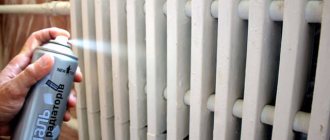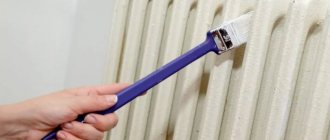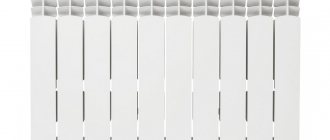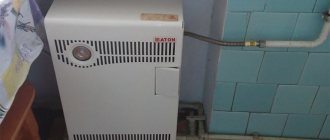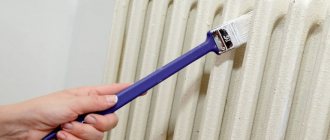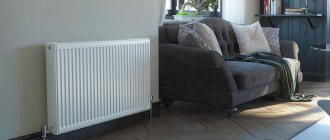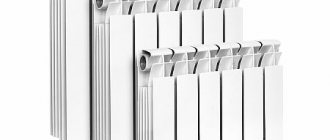Old, yellowed, damaged batteries will ruin the decorative effect of any interior. If the heating radiators work properly and do not require replacement, but the appearance needs updating, you can paint them. Painting radiators is not difficult, but it requires preparation and suitable materials.
What is the best paint for odorless radiators, how to properly prepare the surface, is a primer needed, is it possible to carry out painting work during the heating season - these and other questions are answered in this article.
In order for painting to give a high-quality result for many years, you need to choose the right paint to paint the heating radiators, observing a number of rules and conditions. Let's take a closer look at them.
DekArt MA 15
The manufacturer recommends using paint for treating metal heating pipes. Since the palette of shades is wide, the batteries can be painted in any color, taking into account the characteristics of the overall design of the room.
Advantages:
- high surface protection from aggressive influences;
- wide palette of bright colors;
- the ability to give a pleasant appearance to the radiator, adapting to the interior of the room.
One of the downsides is the pronounced smell.
Painting instructions
- First you need to check that the floor and walls are protected from dye.
- If necessary, add additional cellophane.
- First you need to study the instructions for the coloring composition, stir the mixture to obtain a homogeneous consistency.
- Begin painting from hard-to-reach areas. To do this, use narrow brushes with a curved handle.
- The outer part of the battery is painted with a roller or wide brush.
- You need to paint from top to bottom, this way there will be no smudges and the composition will not splash to the sides.
- To get a high-quality coating, you need to apply 2 layers of paint.
- The second layer should be applied only after the previous one has completely dried.
Sniezka Supermal
Paint has been developed for heating radiators made of cast iron and steel. The product can be used in public areas.
Pros:
- resists atmospheric and mechanical influences;
- low consumption;
- bright shades – 23 colors;
- products comply with all current standards.
No deficiencies were found.
Radiator Festek
This is a one-component, odorless paint for radiators, which guarantees high resistance of the coating to the negative effects of water. After painting, the batteries have a nice matte white color.
Advantages:
- no odor;
- high resistance to moisture and dry abrasion;
- lack of yellowness;
- ability to withstand heat up to 95 degrees;
- quick drying.
The only disadvantage is vulnerability to increased operational loads.
Remontti Assa Tikkurila
This is a Finnish good paint for batteries, which contains an acrylate binder. At the same time, the manufacturer did not use organic solvents. The products are absolutely safe for people suffering from allergies or asthma.
Advantages:
- the dye is made using innovative technologies and high-quality materials;
- high security;
- resistance to washing and abrasion.
The only downside is the high price of the product.
Video description
The process of removing old paint from a cast iron battery using a remover is shown in the video:
The next stage is priming the surface. It is advisable to choose a composition for this on the same basis as the selected paint. For example, radiators under alkyd enamel can be primed with GF-021, which has an anti-corrosion effect.
Advice! Before painting a battery in a living room, you need to protect the floors, walls and nearby furniture from accidental paint on them - cover them with film, newspapers or packaging cardboard.
You can begin painting after the primer has dried. If it is done manually, it is advisable to use two brushes: one curved on an elongated handle for hard-to-reach places and a second regular one for the front surface. Both should have natural bristles.
This brush will allow you to reach the most difficult areas of the radiator Source gidpokraske.ru
Painting begins with the internal surfaces, leaving the façade for last. As a rule, a minimum of 2 passes is required to achieve a smooth and evenly colored surface. The second layer can be applied after the time specified in the instructions and necessary for complete drying.
Balakryl Radet
This high-quality product can be used to paint heating radiators in residential and industrial buildings.
Advantages:
- can be used in rooms where there is high humidity;
- can withstand temperatures of 100 degrees, so the coating on heating radiators does not lose its original appearance for a long time.
There were no deficiencies found in this paint product.
Rules for painting heating appliances
Painting radiators requires special tools. For example, a curved brush, so buy everything you need in advance. The painting process always begins with preparatory activities and only after that the work begins.
Painting cast iron heating radiators.
Preparatory stage
To make painting batteries comfortable, you need to prepare a number of materials and tools in advance. Namely:
- paint;
- 2 brushes – curved and straight;
- primer;
- solvent (except water-dispersion enamel);
- old rags;
- newspapers or polyethylene;
- sanding paper (No. 2);
- protective equipment - rubber gloves, respirator.
If the radiator has already been painted, it must be cleaned of the old coating. Of course, applying from above is acceptable, but this will significantly reduce the level of heat transfer.
After removing the old paint, proceed as follows:
- Sand the surface with an abrasive material to make it smooth.
- Wash with a cloth and detergent.
- Wipe dry - there should be no moisture on the batteries.
- Degrease with solvent - there should not be the slightest grease.
- After drying, treat with a primer.
Tikkurila Empire
If you haven’t decided what paint to paint the batteries with, then you should turn to this development of Finnish specialists. Use a ready-made concentrate and white spirit diluent. After applying the product, the surface becomes semi-matte.
Advantages:
- minimal risk of smudges when painting;
- maximum adhesion to metal surfaces;
- no odor;
- wide palette of shades;
- easy and quick application.
Flaws:
- To apply paint, the room must have an air temperature of 5 degrees and a humidity of 80%;
- careful preparation of the battery is necessary for successful staining;
- high consumption - 12 liters per 1 m2.
Popular vote
What paint for heating radiators would you choose or recommend?
Enamel "Olecolor"
8.89 % ( 4 )
Enamel “TEX Profi”
11.11 % ( 5 )
Enamel "DALI"
8.89 % ( 4 )
Enamel "Prestige Premium"
0.00 % ( 0 )
Enamel "Krafor"
0.00 % ( 0 )
Enamel “AURA LUXPRO TERMO”
15.56 % ( 7 )
Enamel "TEX Universal"
8.89 % ( 4 )
Enamel "Dekor"
6.67 % ( 3 )
Enamel "Lakra"
13.33 % ( 6 )
Enamel “Prestige Ferrum Premium”
6.67 % ( 3 )
Enamel "ETUDE"
4.44 % ( 2 )
Enamel "MOTIP Deco"
4.44 % ( 2 )
Enamel “Decorix 0105-04 DX”
2.22 % ( 1 )
Enamel "Vixen"
0.00 % ( 0 )
Sadolin Master 30
This Swedish product is suitable for painting metal batteries. Makes the surface semi-matte with a pleasant shine.
Advantages:
- high protection against corrosion, rot, mold and mildew;
- no smudges during painting;
- high resistance to atmospheric influences;
- abrasion resistance;
- fits perfectly on different surfaces;
- wide choice of shades.
The downside is the faint smell of paint, so you need to ventilate the room after work.
Is it possible to paint batteries?
There should be no problems with painting old, good-quality cast iron batteries. You just need to choose the right paint for them. But with radiators made of aluminum or stainless steel, the situation is completely different.
Initially, they are painted in a factory using the powder method with heat treatment. It is problematic to apply a new layer of paintwork on top of this paint coating at home with your own hands.
The vast majority of manufacturers of heating devices not made of cast iron consider unauthorized painting of the surface of the battery as a reason for voiding the factory warranty.
Any damage or peeling of the paint layer on a newly purchased radiator is a manufacturing defect. Such equipment is subject to mandatory replacement. No one has yet canceled the service warranty period.
Manufacturers of aluminum and steel radiators in the instructions for their products categorically prohibit their additional painting
After drying, enamel paints create a durable and monolithic layer on the surface, through which air, by definition, cannot pass.
If oxygen is left with even a small chance to seep through the paintwork, then you can immediately forget about protecting the metal from corrosion. And protective functions are often the main reason for painting radiators.
At the same time, in the passports for all heating batteries there is a categorical prohibition on painting over the air outlet of the automatic air vent. If you apply paint to it, it will be impossible to bleed air from the heating system if necessary. This point must be monitored during painting work.
Both aluminum and stainless steel are painted in factories using powder paints, which, after application, are “baked” in special boxes at high temperatures. It is impossible to create the necessary conditions at home yourself.
But ordinary oil and other paints do not last long on such radiators. Due to their low adhesion, they will inevitably peel off aluminum and steel surfaces.
If the paint on an aluminum battery begins to peel off, then it is easier to buy a new radiator - a paint layer applied at home can last a maximum of two to three years
Reliably painting aluminum requires specialized painting equipment, as well as epoxy primers and enamels. All this costs a lot of money.
In addition, the slightest failure to comply with the technology inevitably leads to peeling of the applied coating. There is also an option with anodic oxidation, but this is again technologically complex and requires certain knowledge.
If you have successful experience in painting a car body and the appropriate paint and varnish materials, then you can take on painting an aluminum battery, otherwise it is not worth doing. It is better to purchase a new heating device or simply cover the peeling one with a decorative screen.
A separate topic is convectors with private fins made of steel plates (“comb”) strung on a pair of pipes. Such batteries were often installed in panel high-rise buildings in the 1970–80s. The lamellar ribs themselves cannot be painted. This will lead to a sharp decrease in heat transfer.
At the same time, it will also not be possible to get to the pipes in the middle even with the help of a very narrow brush. These surfaces are best left alone.
Such radiators usually have dampers and decorative screens made of iron. They can and should be painted to give them an aesthetic appearance. Regular heat-resistant paints will do here.
Professional Gloss JOHNSTONE'S
British paint developed for painting metal batteries. It is based on a durable alkyd resin that provides a durable finish.
Advantages:
- perfect coverage;
- pleasant gloss;
- high resistance to negative external influences: shock, temperature.
The disadvantages of the product include the high price.
Which paint to choose
When looking at numerous photos of battery paint, you need to pay attention not only to the picture with the result, but also to know the composition and characteristics of the product:
- Oily. This is a budget option, which is presented in a wide range. But after painting, you will have to wait a long time for the dye to dry and endure a strong, unpleasant odor.
- Acrylic. These dyes dry quickly and do not smell, but it is not always possible to get the perfect shade.
- Alkyd. After their application, the coating is not afraid of high temperatures and mechanical factors. But during painting there is an unpleasant odor.
- Heat resistant. An excellent choice for heating radiators, as the coating remains white without yellowing and withstands high temperatures.
If you buy the right paint and take into account all the recommendations for its application, you can update the condition of the radiators, slightly change the overall design of the room and enjoy the result for a long time.
Reasons for failure
A common reason for unsatisfactory painting results is failure to comply with the enamel drying conditions. It is risky to carry out work during the heating season, when the batteries can turn on and heat up. This common mistake usually ends in an unsightly result. High temperatures cause drying too quickly, weakening the resulting coating. Radiators can be painted at room temperature. Paints are resistant to temperatures up to 100 degrees Celsius, however this does not mean that they can be applied at such temperatures.
Conclusion Hiding old radiators behind heavy curtains or furniture is not a good idea. By hiding radiators behind curtains, we restrict the flow of heat, reducing heating efficiency. Old, cast iron, steel batteries can be quite effective, they are durable and reliable, so replacement is not always advisable. However, it is difficult to consider them as a decorative element of the interior. Modern means can correct an aesthetic defect - old radiators can be painted. In order to get a beautiful, durable end result, it is important to properly prepare the surface, choose the right way to paint the batteries, choosing a paint with good resistance to high temperatures.
